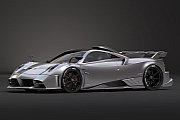history
The brainchild of Italian designer Horacio Pagani, Pagani Automibili is known for making super fast cars and manufacturing a little carbon fibre on the side. The year that Pagani came to be was 1992 but Horacio was dealing with cars and design long before that. In fact, according to some people, his love for cars came very early because at 12 years old he was already making cars out of clay and wood.
That's why by the time he was 20 he had already designed his first race car under the colors of Renault. He honed those design skills in numerous industrial projects until he was noticed by Juan Manuel Fangio, his personal hero who turned out to be the person to introduce him to the home of the supercars at the time: Modena in Italy, where Ferraris and Lamborghinis played.
It was over at Lamborghini where Pagani found a job as a mechanic at first and later as head of the composite material department. Once there he helped in the design and production of LMA Jeep, the Jalpa, the Countach Evoluzione and Golf Caddy.
By 1988 he had already developed a keen interest in carbon fiber and its applications in the automotive industry. The Pagani Composite Research was set up which contributed to the creation of the Diablo, the Lamborghini P140, the L30 and the Diablo Anniversary. All that experience with exotic cars gave Horacio the confidence to fulfill his dream of building his own supercar, the C8 project as it was called initially.
Later, the car would get the name the Fangio F1, to order Pagani's hero, the man who won the F1 championship 5 times. With the rising demand in car design, Pagani established in 1991. Basically, heading his own team, Horacio designed, engineered, modeled and moulded prototype cars.
Only in 1992 was he ready to start work on his Fangio F1 prototype and to help him achieve his dream he started the Pagani Automobili company. A year on and the car had already gone from the drawing board to reality as it was being tested at the Dallara wind tunnel. Then Fangio took the project over to Mercedes, the company which provided the cars to help him achieve his victories.
In 1994 the deal came through and Mercedes Benz agreed to power Pagani with V12 engines. Sadly, Fangio passed away in 1995 and that's when Horacio decided to change the name out of respect. The car then became Zonda C12, after an air current which flows in the Andes in Argentina where Horacio was born. The Pagani Zonda was unveiled at the 1999 Geneva Motor Show.
Based on the Mercedes Group C Silver Arrows and jet fighters design-wise, the Zonda is powered by an V12 DOHC engine made by Mercedes AMG division unique to this model. One of the car's unique features was the circular four pipe exhaust at the rear. Other models include Zonda F, Zonda Roadster F, Zonda R Clubsport.
A new model was announced by Pagani, the C9 to be launched in 2009. It has been said that this new car will not be based on the Zonda but will still be powered by Mercedes AMG engines. This is due to the fact that even if Pagani is an independent company, it works in close relationship with Daimler AG, especially with Mercedes' in-house tuner, AMG.
expand









